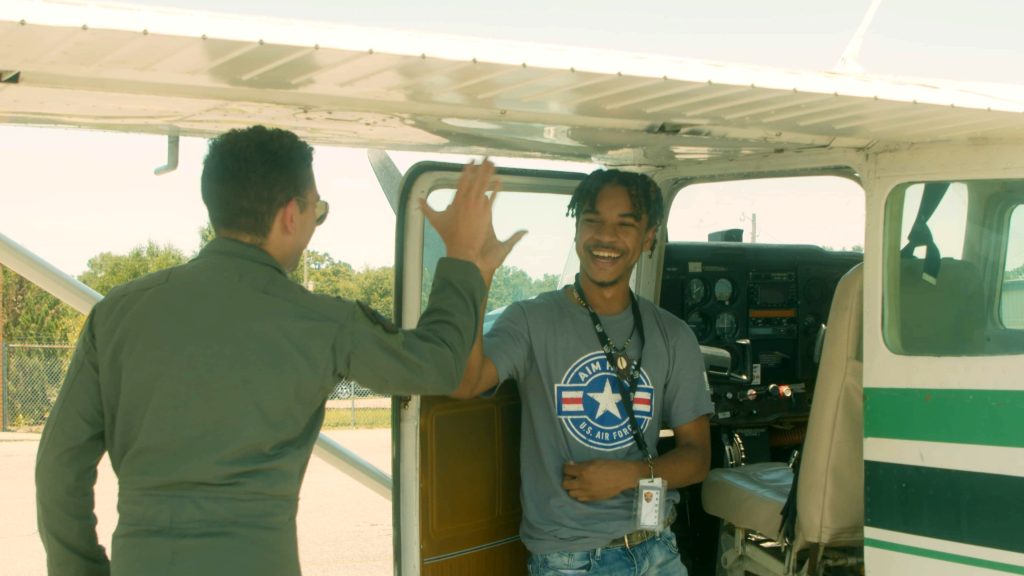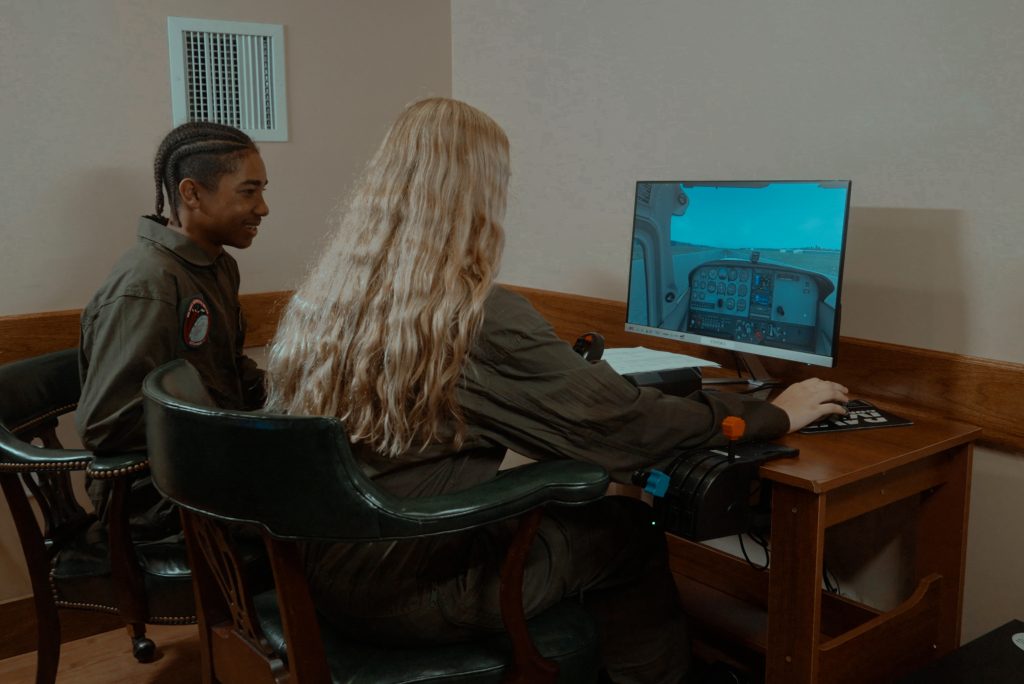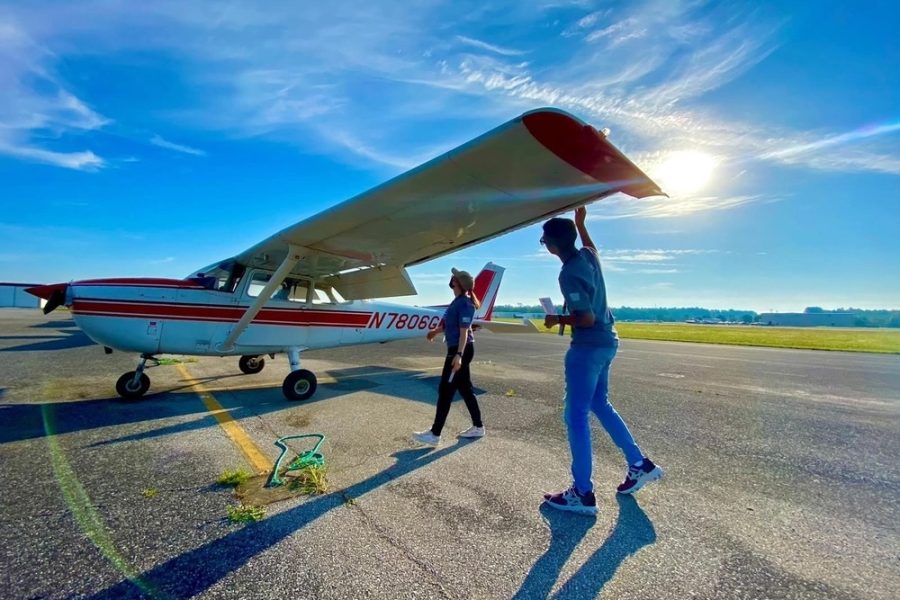Kristopher Koberg was a sophomore at the University of Iowa in 2021 when he saw an Instagram ad for a new program offering free flight hours for high school and college students. An Air Force ROTC cadet hoping to fly for the Air Force, Koberg applied, though he was skeptical at first.
“I tried to find information on the Aim High Flight Academy and I couldn’t find anything online, so I was like ‘man, I hope this is real,’” Koberg told Air & Space Forces Magazine.
As it turns out, it was real, and a few months later Koberg traveled to Milton, Fla., where he and about two dozen other students took part in the first class of Aim High Flight Academy, an aviation scholarship funded by the Air Force that offers a three-week introductory flight program for teenagers and young adults to earn up to 15 flight hours and give them a leg up should they pursue a career in aviation.
The program is intended for aviation outsiders: applicants must have fewer than five powered flight hours to be considered. For Koberg, it was a life-changing experience.
“Those three weeks were the most impactful three weeks on my Air Force career,” said Koberg, now a second lieutenant just starting Air Force pilot training. “It put me on a different trajectory because of the connections I made, the friends I made, and understanding the possibilities that can happen in the Air Force.”

The program started in 2021 after the Air Force realized that a small amount of flight experience can make a big difference in early assessments for pilot training. To become aviators, candidates must score well on the Air Force Officer Qualification Test and the Test of Basic Aviation Skills (TBAS), a kind of cockpit simulator that measures hand-eye coordination, spatial awareness, and multitasking.
The scores from those two tests factor into a candidate’s Pilot Candidate Selection Method (PCSM) score; the higher the PCSM score, the better chances he or she has of landing a rated slot, which includes pilots, combat systems officers, and air battle managers. Prior flight experience helps strengthen the skills tested by TBAS, and the total number of previous flight hours also counts towards the PCSM score. But flight lessons are expensive.
“Right or wrong, people who have more money can pay for flight lessons and those hours will increase your score, no matter what,” said Capt. Adam Ozols, director of Aim High Flight Academy.
In turn, candidates with higher scores have a better chance of making it through the pilot training pipeline: a 2018 RAND report found that more than 20 percent of candidates in the bottom quarter of AFOQT and TBAS scores failed initial flight training, while less than 2 percent of candidates in the top quarter did the same.
Past flight experience showed a similar correlation. “Candidates with more hours of flying experience were also less likely to be eliminated” from initial flight training and primary pilot training, RAND wrote.
Amid an ongoing pilot shortage, Aim High Flight Academy is an effort to “level the playing field,” Ozols said. “Those 15 hours will go a long way and it will increase your score and make you more competitive.”
The Air Force itself does not teach Aim High students: instead, the students are split among nine universities with aviation programs around the country, where they receive three weeks of flight training from FAA-certified flight instructors. Travel, training, food, and lodging are all paid for by the Air Force, and some students even fly their first solo flight by the end of it. The program started with about 72 students in 2021 and has grown to 268 students this year.
Last year, 70 percent of the students came from underrepresented demographic groups, and this year’s share is 68 percent. Ozols emphasized that the goal is not diversity for diversity’s sake, but rather to draw talent from as wide a pool as possible in order to strengthen the Air Force. He compared it to a college football team bringing athletes in from all over the country rather than just one state.
“You want that diversity and inclusion so that you can have the best people on your team,” he said.

Aim High is one of several programs under Air Force Recruiting Service’s Detachment 1, where one of the goals is to boost the diversity of the Air Force pilot corps, the vast majority of which are White men. Another program is Aviation Inspiration Mentorship (AIM) teams: rated officers, non-rated officers, and enlisted Airmen who field questions about military service and build relationships through community outreach events.
AIM mentors play an important role at Aim High, since so few Americans have a family member in the military today, said Leslie Brown, chief of public affairs for the Air Force Recruiting Service.
“The questions can be quite basic: Can I have a family? Can I have a pet? Can I have a car? Can I wear civilian clothes?” Brown said, referencing the questions she heard during an “Ask an Airman” event in 2018. “That’s how much of a disconnect there is.”
It can also be helpful for ROTC cadets; chatting with Air Force aviators was one of the highlights of Koberg’s Aim High experience.
“Each and every one of them said their plane was the best,” he recalled. “That meant wherever I end up, I will fall in love with it, so having that security was just fantastic.”
Years later, after commissioning as a second lieutenant, Koberg paid it forward by mentoring at an Aim High class earlier this summer at Tennessee State University.
“I think just us being there really allows the students to connect a face to what the uniform is,” he said. “We’re not just a bunch of random people: we have a story, we’re real, and we help them out.”
Though the program was just three weeks long, Koberg found himself building deep bonds with the students, talking about life goals, interpersonal relationships, and the joy of flying. It was a “full circle” moment.
“You’re not just an Air Force member, you’re a mentor to them,” he said.
The impact of Aim High Flight Academy is hard to quantify, because the Air Force cannot collect data on people under the age of 17, Brown said. The next step is to reach back to past students and ask if they wound up joining the military, going to college, pursuing a career in aviation, or some other path.
In the meantime, another challenge is meeting the rising tide of applicants. Last year Aim High received around 1,500 applications, Ozols said. While any plans to possibly expand the program are above his pay grade, Ozols hopes it will continue.
“It can be really expensive to get flight hours, so for us to be able to spread that wealth out and give young adults the chance to do that is what we really focus on,” he said.
The application window for the 2025 Aim High Flight Academy runs from Oct. 1-31, and application details can be found on the Air Force Recruiting Service website.
“It’s for anyone and everyone that has maybe a little bit of interest in aviation,” Koberg said. “It doesn’t matter where you’re from or who your parents are. We want anyone who’s interested to have that opportunity.”
